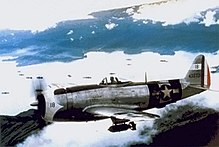201st Fighter Squadron (Mexico)
| 201st Fighter Squadron | |
|---|---|
| Escuadrón Aéreo de Pelea 201 | |

|
|
| Active | July 24, 1944 – present |
| Country |
|
| Branch |
|
| Type | Fighter-bomber squadron |
| Role | Air support |
| Size | 25 P-47D aircraft, 30 pilots, 300 personnel |
| Part of |
U.S. Fifth Air Force 58th Fighter Group |
| Garrison/HQ | Cozumel, Quintana Roo |
| Nickname(s) | Aztec Eagles |
| Colors | Purple, yellow |
| Mascot(s) | Pancho Pistolas |
| Engagements | Chiapas conflict |
The 201st Fighter Squadron (Spanish: Escuadrón Aéreo de Pelea 201) was a Mexican fighter squadron, part of the Mexican Expeditionary Air Force that aided the Allied war effort during World War II. The squadron was known by the nickname Águilas Aztecas or "Aztec Eagles", apparently coined by members of the squadron during training.
The squadron was attached to the 58th Fighter Group of the United States Army Air Forces (USAAF) during the liberation of the main Philippine island of Luzon in the summer of 1945. The pilots flew Republic P-47D-30-RA Thunderbolt single-seat fighter aircraft carrying out tactical air support missions.
The Mexico City Metro Line 8 station Metro Escuadrón 201 is named after the squadron, whilst it was also the subject of the Mexican film Escuadrón 201, directed by Jaime Salvador and released in 1945. In November 22, 2004, the squadron was awarded the Philippine Legion of Honor, with a rank of Legionnaire, by then president Gloria Macapagal-Arroyo. The unit is still active at present, flying the Pilatus PC-7.
The Escuadrón Aéreo de Pelea 201 (201st Air Fighter Squadron) was composed of more than 300 volunteers; 30 were experienced pilots and the rest were groundcrew. The ground crewmen were electricians, mechanics, and radiomen. Its formation was prompted by the attack by German submarines against Mexican oil tankers Potrero del Llano and Faja de Oro, that were transporting crude oil to the United States. These attacks prompted President Manuel Ávila Camacho to declare war on the Axis powers on May 22, 1942, and to join Brazil as the only two Latin American countries to actually send military forces overseas.
...
Wikipedia
